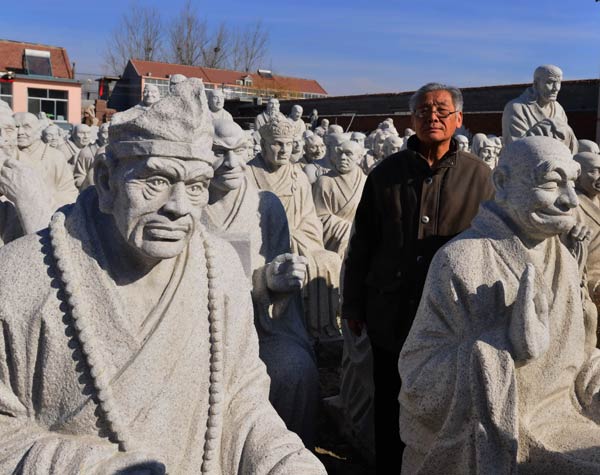Former PLA pilot creates Silk Road statues for Italy
|
Sculptor Chen Xiulin with statues of the arhats at his residence-cum-studio on the outskirts of Weifang city in Shandong province.Provided To China Daily |
Chen Xiulin, when in his 20s, flew a military plane over areas where China had conducted its first nuclear missile test in 1966, to collect some air samples.
But back then he didn't realize that one day he would take a route that's rather different for a People's Liberation Army aviator - that of a sculptor.
The 78-year-old Weifang native, from eastern China's Shandong province, is now working day and night to finish a set of bronze sculptures for the 2015 Milan World Expo. His work at the event to be held in May will depict scenes from China's trade and cultural exchanges with other parts of the world along the ancient Silk Road.
His 170-meter-long sculpture, which comprises 23 statues, will be shipped to Italy in March and placed at the Sino-Italy Pavilion for display in Venice, a sub-venue for the exposition, according to Lu Yintao, the executive director for Chinese Art and Craft Association and an art adviser to the pavilion team.
Among Chen's other works invited to be showcased at the global fair are his stone statues of the 500 Arhats, disciples of the Buddha on advanced paths of enlightenment.
"Chen's portrait sculptures, especially the arhat statues, are perfectly proportioned and extremely vivid in facial expressions. Each one can rival world-famous works," says Lu, who introduced the former pilot's works to the expo organizing committee.
"The expo will be the best international stage to showcase Chinese culture. I hope my works can help people better know Chinese traditional culture," Chen says.
Born in Weifang, which is among the country's main production centers of traditional woodprint painting, Chen was fascinated by local folk artisans since his childhood.
After joining the air force in 1961, he studied drawing and sculpting techniques and copied thousands of illustrations from books in his spare time.
"The first work I carved out nearly 50 years ago was based on images of my comrades-in-arms. The sculpture is still on display at the Chinese Aviation Museum in Beijing," Chen says.
In 1966, after China's first nuclear missile test, Chen and two other air force colleagues accepted the assignment of collecting air samples over the blast site. The exposure to radiation made the three extremely ill five years later, and Chen was the lone survivor. He retired from the air force in his 30s.
Since then he has immersed himself in the world of sculptures and other artworks.
"I push myself to work hard as long as I think of my colleagues who died in their early years," he says.
In the front courtyard of his residence-cum-studio on the outskirts of Weifang city stand statues of the arhats. It took Chen nearly 30 years to complete them. Slightly larger than life size, the statues depict the Buddhist monks in different ages ranging from energetic youth to old, toothless people.
"They are different from traditional solemn Buddhist statues. I've tried to show these monks' true feelings and affections based on my experiences and observations in real life," Chen says, adding that each statue has a different facial expression, body posture and personality, and seems to be telling the viewer a story.
Chen spent two years visiting numerous temples in India, Nepal and the Tibet autonomous region where Buddhist paintings and sculptures have been preserved, in a bid to understand his subjects well.
"It usually took one or two months to create a statue, but some even took several years as I came across new ideas while making them," says Chen.
Besides the sculptures, Chen has made statues of numerous Chinese mythology, historically and cultural figures such as Confucius and his 72 disciples.
"Traditional Chinese culture includes a wide range of virtues such as benevolence, faith, tolerance and harmony," Chen says. "I try to use my sculptures to express the ideas ... which are also needed in today's world."
Chen rises at 5 am and works for more than 12 hours daily. There's still much he needs to do, he says. "I'm always afraid of not having enough time."
wangqian@chinadaily.com.cn



















